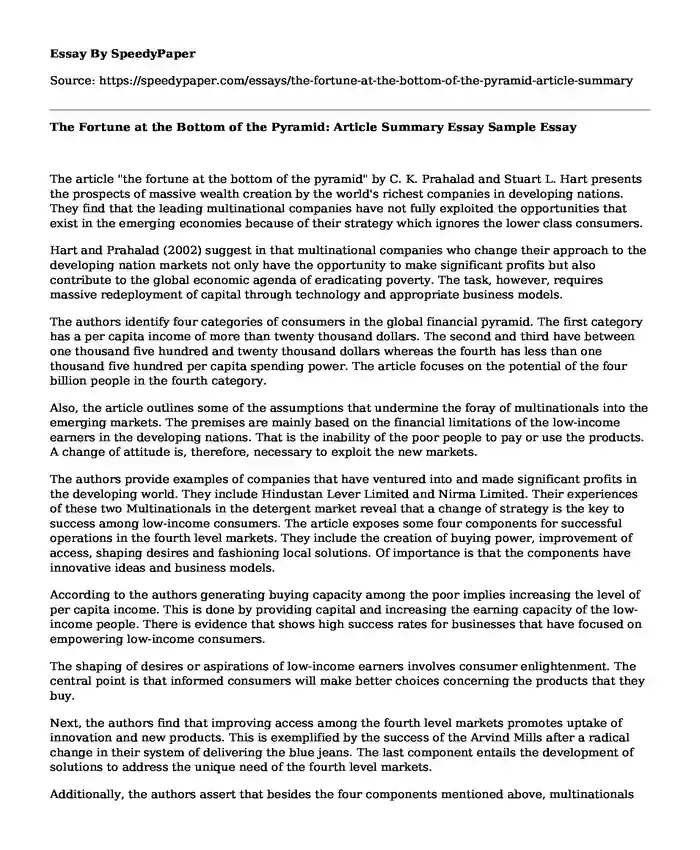The article "the fortune at the bottom of the pyramid" by C. K. Prahalad and Stuart L. Hart presents the prospects of massive wealth creation by the world's richest companies in developing nations. They find that the leading multinational companies have not fully exploited the opportunities that exist in the emerging economies because of their strategy which ignores the lower class consumers.
Hart and Prahalad (2002) suggest in that multinational companies who change their approach to the developing nation markets not only have the opportunity to make significant profits but also contribute to the global economic agenda of eradicating poverty. The task, however, requires massive redeployment of capital through technology and appropriate business models.
The authors identify four categories of consumers in the global financial pyramid. The first category has a per capita income of more than twenty thousand dollars. The second and third have between one thousand five hundred and twenty thousand dollars whereas the fourth has less than one thousand five hundred per capita spending power. The article focuses on the potential of the four billion people in the fourth category.
Also, the article outlines some of the assumptions that undermine the foray of multinationals into the emerging markets. The premises are mainly based on the financial limitations of the low-income earners in the developing nations. That is the inability of the poor people to pay or use the products. A change of attitude is, therefore, necessary to exploit the new markets.
The authors provide examples of companies that have ventured into and made significant profits in the developing world. They include Hindustan Lever Limited and Nirma Limited. Their experiences of these two Multinationals in the detergent market reveal that a change of strategy is the key to success among low-income consumers. The article exposes some four components for successful operations in the fourth level markets. They include the creation of buying power, improvement of access, shaping desires and fashioning local solutions. Of importance is that the components have innovative ideas and business models.
According to the authors generating buying capacity among the poor implies increasing the level of per capita income. This is done by providing capital and increasing the earning capacity of the low-income people. There is evidence that shows high success rates for businesses that have focused on empowering low-income consumers.
The shaping of desires or aspirations of low-income earners involves consumer enlightenment. The central point is that informed consumers will make better choices concerning the products that they buy.
Next, the authors find that improving access among the fourth level markets promotes uptake of innovation and new products. This is exemplified by the success of the Arvind Mills after a radical change in their system of delivering the blue jeans. The last component entails the development of solutions to address the unique need of the fourth level markets.
Additionally, the authors assert that besides the four components mentioned above, multinationals can enter into alliances to broaden the influence and productivity in the low-income markets. Changing cost structures, creating job opportunities, conduction research and development and building local support bases are also essential strategies the can enhance the profit agenda of multinational in the emerging markets.
To conclude, the article outlines the business opportunities that exist for multinational corporations in the developing nations. The authors present some of the strategies that can help big businesses to thrive within low-income populations of the world.
References
Prahalad, C., & Hart, S. L. (2002, January 10). The fortune at the bottom of the pyramid. Retrieved from Strategy Business: https://www.strategy-business.com/article/11518?gko=9a4ba
Cite this page
The Fortune at the Bottom of the Pyramid: Article Summary Essay Sample. (2022, Jul 19). Retrieved from https://speedypaper.net/essays/the-fortune-at-the-bottom-of-the-pyramid-article-summary
Request Removal
If you are the original author of this essay and no longer wish to have it published on the SpeedyPaper website, please click below to request its removal:
- Healthcare Essay Sample: Milieu and CAM Therapy
- Essay Sample on Why Australian Banks Came Out Strong from the Global Financial Crisis
- Free Essay on Nursing Education
- Motives of the American Revolution, Free Essay in American History
- Paper Example. American Dream in Film Taxi Driver
- Free Essay: The Cellular Nature of Alzheimer's Disease
- Essay Sample on The Intersectional Approach Advances Social Change and Social Justice Work
Popular categories





